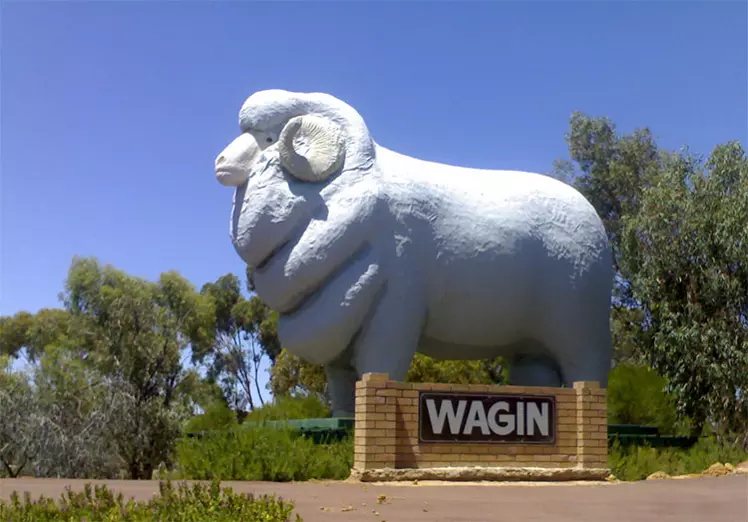1. Jade Chinese zodiac, New York City, USA
As part of the Metropolitan Museum of Art’s permanent collection of Chinese Decorative Arts, this zodiac is usually on display in Gallery 222 and always on display online. The rat, ox, tiger, hare, dragon, snake, horse, sheep, monkey, rooster, dog, and pig still have a significant role in Chinese culture; in 2015 the Year of the Sheep (sometimes interchanged with a goat) starts on 19 February. Early zodiacs were depicted in wall paintings of the 6th century; pottery figurines were popular in the Tang dynasty (618–907); the Met’s jade animals are 19th-century.
The Met is closed Thanksgiving Day (27 November 2014), 25 December, 1 January and the first Monday in May (4 May 2015)

2. Giant ram, Wagin, Australia
It’s a long way, geographically and culturally speaking, from the Big Apple of New York to the Big Sheep of Wagin, Western Australia. But ‘big things’ are a welcome diversion on the long unwinding roads of the Australian outback; one of several big sheep around the country, this giant ram stands an impressive 7m tall and 15m long and gazes across the town, a monument to the local merino industry that helped to fund Wagin’s historic streetscape, established in 1889.
3. Barbary sheep, North Africa
Hardy Barbary sheep are Africa’s only wild sheep. Called aoudad by the region’s Berber people, they’re found in barren mountains where they somehow manage to find enough water from vegetation and dew to survive. Barbaries have an exceptional ability to remain motionless and barely visible when threatened – handy, given that their heavy horns lure hunters in countries where they have been introduced, such as the USA. Seeing them in the wild requires time, patience and good local knowledge: WWF-US runs tours to the Sahara and Atlas Mountains in Morocco, one of the sheep’s native habitats.

4. Dolly the sheep, Edinburgh, Scotland
Dolly (5 July 1996–14 February 2003), a Finn Dorset sheep, made world headlines and graced the cover of Time magazine in 1997. She was the first mammal to be cloned from adult (sheep) cells, and the only one from 277 cloning attempts to survive to adulthood. Why was she called Dolly? Ian Wilmut, one of the cloners, said ‘Dolly is derived from a mammary gland cell and we couldn’t think of a more impressive pair of glands than Dolly Parton’s’. Dolly’s stuffed remains are on show in the Science and Technology galleries at the National Museum of Scotland.

5. Museum of Norwegian Knitting Industry, Norway
Between 1859 and 1989, Salhus Tricotagefabrik made fine woollens; it was the first mechanised knitwear factory in Norway. Most of its products weren’t seen in public though; the firm specialised in underwear. The factory reopened as a museum in 2001; guides unravel the mysteries of carding, spooling and knitting during daily tours and machines with cogs and wheels of polished brass are kept in working order. There are hands-on workshops for kids on alternate Sundays.
6. Sheep dog trials, Ontario, Canada
Although open to all breeds of dog, Border collies rule the roost in the annual sheep dog trials in Kingston, Ontario. Finalists compete in the Gather (fetching sheep), the Drive (taking sheep through an obstacle course), the Shed (separating five sheep from the flock) and the Pen (leading these five sheep to a separate pen). The co-stars are 600 Dorset ewes, with just a hint of exotic Romanov and rural Cheviot in their heritage. Sideshows are kid-heaven, including sheep shearing and pony rides.
7. Sheep shearing, New Zealand
Get up close and personal with the woolly mainstay of New Zealand’s economy: near Queenstown, several farms offer tours that include sheep feeding, petting and shearing. Sound too low-key? For a more competitive view of the industry, visit the Golden Shears championship in Masterton. Held annually since 1958, this three-day event in late February or early March hosts eye-popping sessions of speed-shearing, wool handling and wool pressing. And if it all gets too much, relax in the paddock with the four-legged participants.
8. Sheepskin clothing, Nepal
In the swinging ’60s, sheepskin coats were high fashion for hippies. Today they remain functional – rather than fashionable – winter wear for mountain people throughout Asia: sheepskin, unlike leather, is tanned with the fleece intact which means an extra layer of effective insulation. In villages in Nepal, traditional wear for Sherpa men is a long-sleeved robe called a chhuba, tied at the waist with a cloth sash called a kara. Chhubawere made from thick homespun wool, and a variant called lokpa was made from sheepskin. Women traditionally wear long-sleeved floor-length dresses of thick wool called tongkok.
Ask around the Thamel market, in Nepal’s capital Kathmandu, for sheepskins, woollen carpets and knitwear.
9. Whole sheep banquet, Xinjiang, China
Mutton reigns supreme in this mostly Muslim region. One Uighur speciality that makes use of the sheep from head to tail is morxueke; a whole sheep banquet where each body part contributes to several separate dishes including a sort of spicy intestinal haggis. Just as tasty but possibly less confronting (and certainly easier to access) is the food at Xibo Restaurant in Shanghai, where lamb is sourced locally and dishes lean heavily on traditional Uighur recipes.
10. The Woolsack, London, England
Seat of the Lord Speaker in the House of Lords, the Woolsack is a large square bale of wool, covered in red cloth, with no arms or back. The tradition dates back to the 14th-century reign of Edward III, when the wool trade was the country’s most important industry and the Woolsack was stuffed only with precious English wool. More recently, in a scandalous revelation in 1938, it was discovered that the Woolsack was in fact filled with horsehair! These days it is stuffed with wool from around the Commonwealth.
Source: News
